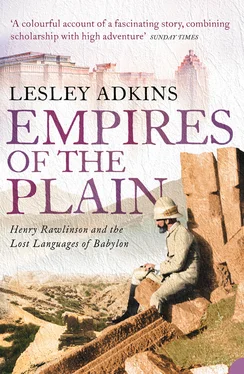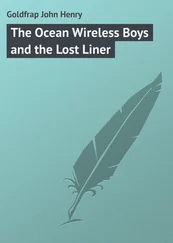To copy the inscriptions at Bisitun would be, Porter believed, an enormous undertaking: ‘to transcribe the whole of the tablets, could I have drawn myself up sufficiently high on the rock to be within sight of them, would have occupied me more than a month. At no time can it ever be attempted without great personal risk; yet I do not doubt that some bracket on the surface might be found, to admit a tolerably secure seat for some future traveller, who has ardour and time, to accomplish so desirable a purpose.’ 5
In the early summer of 1836, Rawlinson used every spare minute to make repeated climbs up to the narrow ledge below the inscriptions and copy the initial lines of the first column of the Old Persian. He had deduced that there were three different types of cuneiform, as on the Elwand inscriptions, and he chose to start with the Old Persian script that appeared the most simple. Nobody had ever before managed to climb right up to these inscriptions, let alone record them, and even four years later the artist Eugène Flandin found the task virtually impossible. He and an architect, Pascal Coste, had been instructed by the French government to copy all the ancient monuments and inscriptions of Persia, and in July 1840 Flandin went on his own to Bisitun. He managed to climb to the ledge, but once there he found it impossible to move. His description of the ascent and descent is in stark contrast to Rawlinson’s understated record of the climb, and highlights Rawlinson’s nerve and mountaineering skills: ‘Mount Bi-Sutoun rises up in a pyramidal shape, black and savage,’ began Flandin. ‘It is one of the highest summits of the chain. The bas-relief, set in a reflex angle of the mountain … is only seen with great difficulty from below. In order to draw it, it is necessary to get close up by climbing some of the blocks that litter the foot of the mountain, which can be done up to a certain height. There then remains quite a great height still, so that it is necessary to use a telescope. The steep rock slope below this sculpture makes access almost impossible, so aiding its preservation … I wanted to try to get to the inscriptions that I had only been able to see from the foot of the mountain … I folded up my tent in the evening and I left for Bi-Sutoun [from Taq-i Bustan] … and crossed the lonely plain, and, keeping straight ahead, I went alongside the foot of the mountains. The day had been very stormy. The summits of Mount Bi-Sutoun were covered with great reddish clouds … The thunder rumbled across their thick layers … the flashes of lightning were recurring like prolonged echoes.’ 6
The moon then rose, dispersing the clouds and, Flandin wrote, ‘its silver light, spread over the mountain, changed the savage and sad colours that the leaden clouds had given to the rocks of Bi-Sutoun into fantastic and strange effects. I had returned to Bi-Sutoun with the intention of copying the inscriptions. I was hoping to succeed by using two ladders that I had brought from Kermanshah and was counting on putting the two together. By placing them as high as possible on the rocks, I was hoping to reach a little ledge that was at the level of the engraved tablets. But a vain hope … What to do? It was absolutely impossible without a specially constructed scaffolding, and positioning it would have encountered great obstacles. Besides … I had no wood, no ropes, and the region had no workman who could put it together.’ 7
Nevertheless, Flandin was determined to reach the inscriptions. ‘I wanted to make an attempt’, he explained, ‘to try to climb the polished and perpendicular rocks by the aid of some fissures that afforded a means of support. I left my shoes, so as not to slip, I hung on by my hands and feet to all the rough patches that I was able to seize hold of. In this way I climbed the rock with difficulty, stopping after each burst in order to prepare for a new exertion, and fearing, with every movement, that I would be hurtled to the bottom. I don’t know how long it took to get to my goal, but it seemed to me to be a long time, and I was fearing I would not succeed when I felt under my hand the edge of the ledge. Not before time, because my tired, grazed fingers had no more strength to haul me up … I had bloody feet and hands. At last I was on the projecting rock, below the inscriptions that I could clearly see. I took a quick breath, after which I examined the engraved tablets. What sorrow I had, after going to so much trouble, on realizing that it was impossible to take a copy. This impossibility resulted from the height that they were still at, as well as the narrowness of the ledge on which I found myself forced against the rock, without being able to move back a single inch. I had therefore climbed the mountain for nothing, and the reward for my troubles was that I could only state simply that the inscriptions are all cuneiform, engraved in seven columns, each containing 99 lines, and that above the figures, there are several more little groups of similar characters.’ 8
Flandin might have been even more despondent if he had known that Rawlinson had already recorded all this information – and much more besides. ‘But that wasn’t all,’ Flandin complained, ‘the most difficult thing was to return back down. I was at a height of 25 metres, and I could not think of any way of climbing down other than backwards, taking hold of and gripping the rock with my fingernails, as I had done in climbing up: this was really like the gymnastics of a lizard. I was therefore very happy to reach the bottom, but wounded, cut by the sharp angles of stones, completely torn and bloody.’ 9
Several years later, in 1850, Rawlinson recorded that the task of climbing this precipice was not especially challenging: ‘Notwithstanding that a French antiquarian commission in Persia described it a few years back to be impossible to copy the Behistun inscriptions, I certainly do not consider it any great feat in climbing to ascend to the spot where the inscriptions occur. When I was living in Kermanshah fifteen years ago, and was somewhat more active than I am at present, I used frequently to scale the rock three or four times a day without the aid of a rope or ladder: without any assistance, in fact, whatever.’ 10 With the age-old rivalry between the French and English, Rawlinson was doubtless playing down the daunting task, but the very fact that he had the skill and stamina to repeat such a climb, day after day, speaks for itself.
By mid-summer 1836, Rawlinson had sufficient cuneiform copied to be able to compare the Elwand and Bisitun inscriptions. Although he had not yet seen Grotefend’s publication, he later realized that he followed the same method of analysis of working out values of cuneiform signs, because he deduced that the Persian equivalents of the names Hystaspes, Darius and Xerxes would be present in the inscription: ‘It would be fatiguing to detail the gradual progress which I made … The collation of the two first paragraphs of the great Behistun Inscription with the tablets of Elwend supplied me, in addition to the names of Hystaspes, Darius, and Xerxes, with the native forms of Arsames, Ariaramnes, Teispes, Achaemenes, and Persia, and thus enabled me to construct an alphabet which assigned the same determinate values to eighteen characters that I still retain after three years of further investigation.’ 11
He wrote to his sister Maria in early July of his ambitions and progress: ‘My antiquarian studies go on quietly and smoothly, and despite the taunt which you may remember once expressing of the presumption of an ignoramus like myself attempting to decypher inscriptions which had baffled for centuries the most learned men in Europe, I have made very considerable progress in ascertaining the relative value of the characters.’ 12 Since his stay in Baghdad a few months earlier, he no longer felt so isolated: ‘Now that I am assisted by the erudition of my neighbour Colonel Taylor of Baghdad, the best scholar living probably in the ancient languages of the East, I aspire to do for the cuneiform alphabet what Champollion has done for the hieroglyphics – when you hear the archaeologists of Europe enquire who this Rawlinson is who has shed so extraordinary a light over ancient history both sacred and profane, you will probably feel a thrill of greater pleasure than in acknowledging yourself the sister of the madcap … My character is one of restless, insatiable ambition – in whatever sphere I am thrown my whole spirit is absorbed in an eager struggle for the first place – hitherto the instability of youth has defeated all my ends, but now that advancing years are shedding their quietizing influence over my mind, I trust to be able to concentrate my energies as to proceed steadily and surely to the goal … I am now therefore compelled to rest upon my oars until the arrival of the works I have commissioned from England opens a new field to my enquiry or I can steal a fortnight’s leave to gallop to Baghdad and cull fresh honey from the treasures of Col. Taylor’s library.’ 13
Читать дальше












